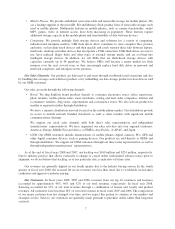SanDisk 2008 Annual Report Download - page 21
Download and view the complete annual report
Please find page 21 of the 2008 SanDisk annual report below. You can navigate through the pages in the report by either clicking on the pages listed below, or by using the keyword search tool below to find specific information within the annual report.
products and standards with higher memory capacities and other enhanced features. Any new applications,
products, technologies, standards or enhancements we develop may not be commercially successful. The success
of new product introductions is dependent on a number of factors, including market acceptance, our ability to
manage risks associated with new products and production ramp issues. New applications, such as the adoption
of flash-based SSDs that are designed to replace hard disk drives in devices such as computers and servers, can
take several years to develop. We cannot guarantee that manufacturers will adopt SSDs or that this market will
grow as we anticipate. For the solid-state drive market to become sizeable, the cost of flash memory must decline
significantly so that the cost to consumers is competitive with the cost of hard disk drives. We believe this will
require us to implement multi-level cell, or MLC, technology into our SSDs, which will require us to develop
new controllers. There can be no assurance that our MLC-based SSDs will be able to meet the specifications
required to gain customer qualification and acceptance or will be delivered to the market on a timely basis as
compared with our competitors. Other new products, such as slotMusic™, our pre-recorded flash memory cards,
may not gain market acceptance, and we may not be successful in penetrating the new markets that we target. For
example, our Sansa®Connect™product, a Wi-Fi®enabled MP3 player, did not achieve market acceptance or our
expected sales volume.
New applications may require significant up-front investment with no assurance of long-term commercial
success or profitability. As we introduce new standards or technologies, it can take time for these new standards
or technologies to be adopted, for consumers to accept and transition to these new standards or technologies and
for significant sales to be generated, if at all.
Competitors or other market participants could seek to develop new standards for flash memory products
that, if accepted by device manufacturers or consumers, could reduce demand for our products. For example,
certain handset manufacturers and flash memory chip producers are currently advocating the development of a
new standard, referred to as Universal Flash Storage, or UFS, for flash memory cards used in mobile phones.
Intel and Micron have also developed a new specification for a NAND flash interface, called Open NAND Flash
Interface, or ONFI, which would be used primarily in computing devices. Broad acceptance of new standards,
technologies or products may reduce demand for some of our products. If this decreased demand is not offset by
increased demand for new form factors or products that we offer, our results of operations would be harmed.
Alternative storage solutions such as high bandwidth wireless or internet-based storage could reduce the
need for physical flash storage within electronic devices. These alternative technologies could negatively impact
the overall market for flash-based products, which could seriously harm our results of operations.
Consumer devices that use NAND-based flash memory do so in either a removable card or an embedded
format. We offer NAND-based flash memory products in both categories; however, our market share is strongest
for removable flash memory products. If designers and manufacturers of consumer devices, including mobile
phones, increase their usage of embedded flash memory, we may not be able to sustain our market share. In
addition, if NAND-based flash memory is used in an embedded format, we would have less opportunity to
influence the capacity of the NAND-based flash products and we would not have the opportunity for additional
after-market retail sales related to these consumer devices or mobile phones. Any loss of market share or
reduction in the average capacity of our product sales or any loss in our retail after-market opportunity could
harm our operating results and business condition.
We are developing X4, a new generation of MLC technology which is expected to contribute to planned
future memory cost reductions. The performance, reliability, yields and time-to-market of X4 technology is
uncertain, and there can be no assurance of the commercial success of this technology.
In addition, we are investing in future alternative technologies, particularly our 3D semiconductor memory.
We are investing significant resources to develop this technology for multiple read-write applications; however,
there can be no assurance that we will be successful in developing this or other technologies or that we will be able
to achieve the yields, quality or capacities to be cost competitive with existing or other alternative technologies.
17
























